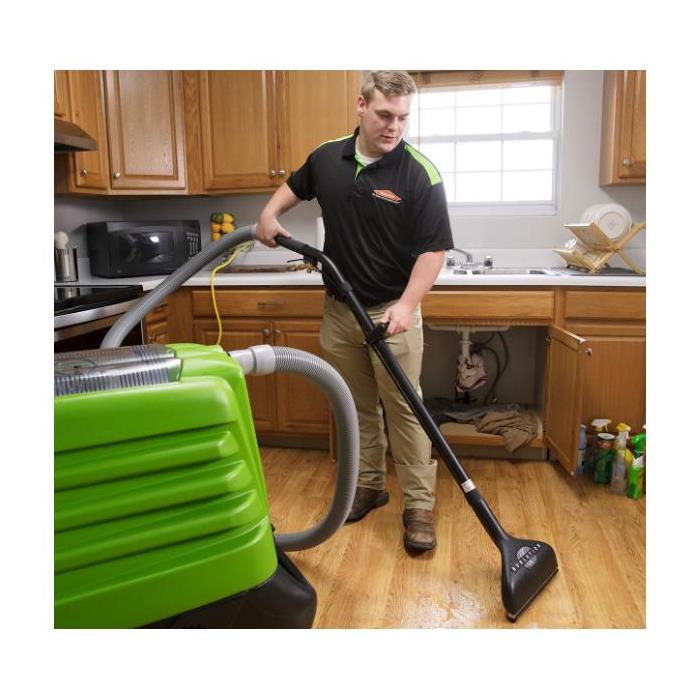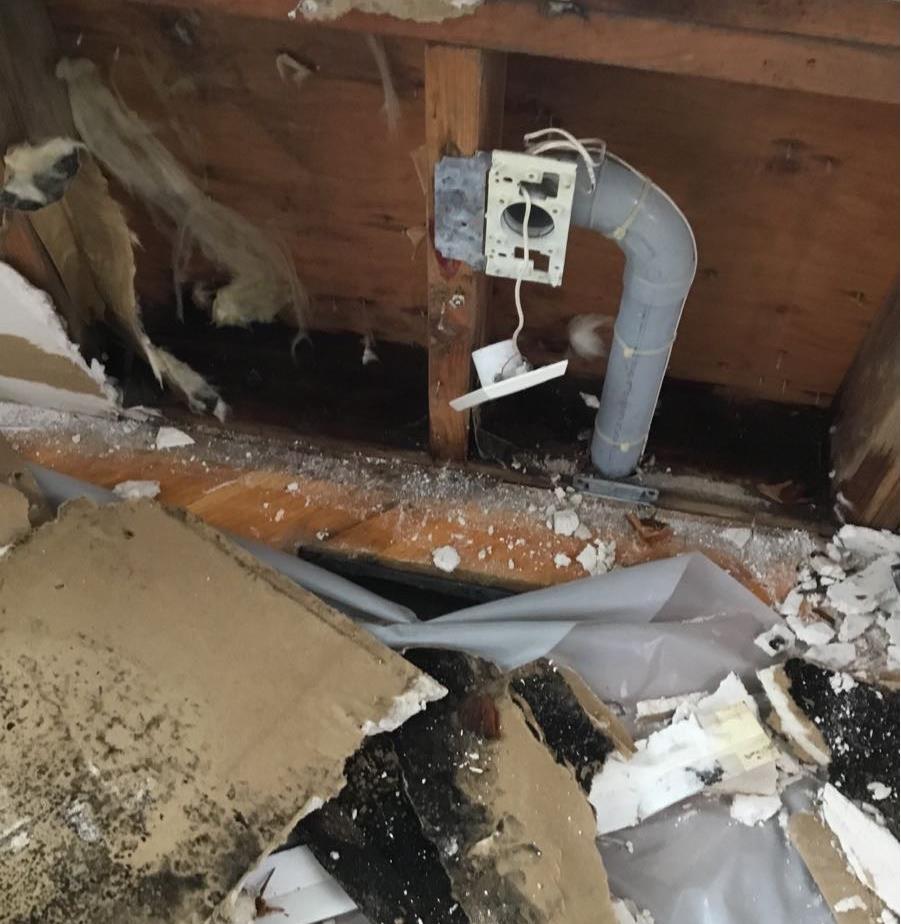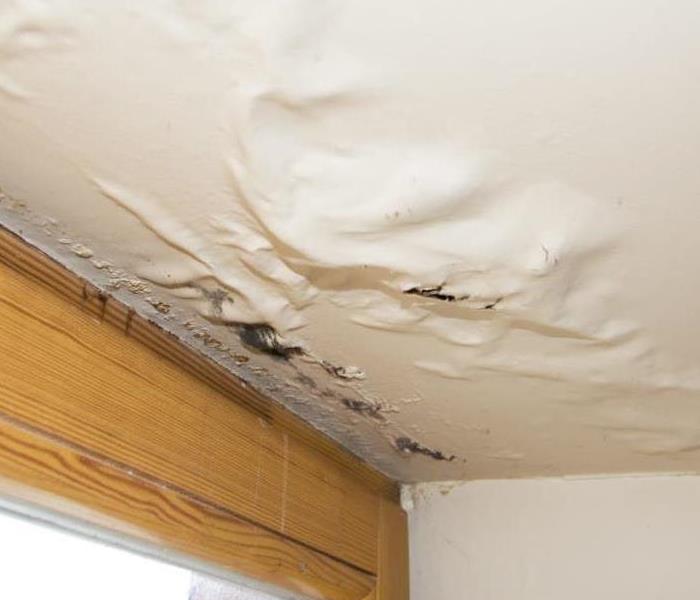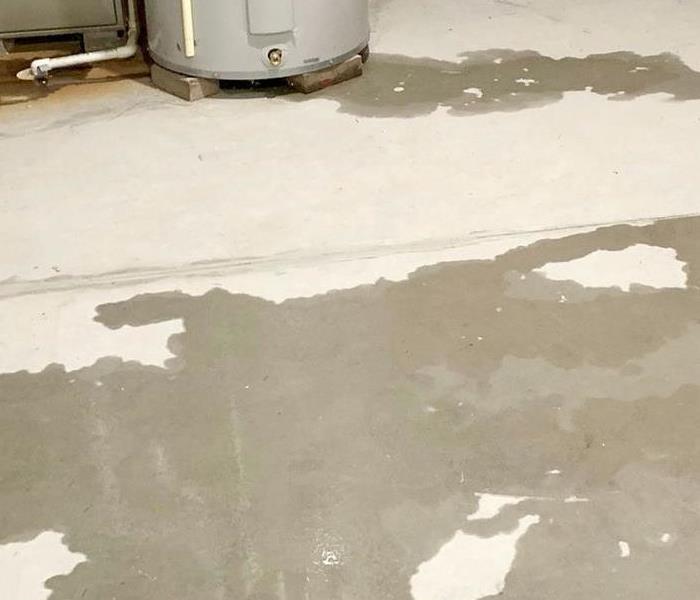Recent Water Damage Posts
What to do if Water invades your home
4/4/2023 (Permalink)
If you experience water damage in your home. Here's what you should do:
1. Stop the Water Source: If the water damage is due to a burst pipe, leaking appliance, or other internal issue, try to stop the water flow.
2. Removing Excess Water
3. Remove Damaged Items: from the area, yet do not discard.
4. Document the Damage: Take photos or videos of the water damage and any affected belongings. This documentation may be useful for insurance purposes.
5. Contact Your Insurance Company: Notify your insurance company of the water damage as soon as possible to start the claims process.
7. Call a Professional: contacting a professional restoration company l SERVPRO of East End and Hamptons to assess and handle the clean up.
Water Removal from your home in Bridgehampton to avoid Mold Growth
4/3/2023 (Permalink)
Need Water Removal Services in Bridgehampton - Call SERVPRO of East End and Hamptons
Homeowners should always arrange for water removal after a leak in there home in Bridgehampton. On occasion they feel that the water will evaporate on its own, and their flooring materials and walls will dry naturally.
SERVPRO of East End and Hamptons can help you with water removal and mold removal at your residence in Bridgehampton. The best approach is to immediately remove all excess water. We use dehumidifiers and air movers to dry the structure and contents.
Mold can cause health effects, especially for the very young, the elderly with respiratory problems.
Call SERVPRO of East End and Hamptons for water removal in East Hampton. We can help.
631-653-9595
SERVPRO Helps Southampton Homeowners with Water Damage
11/7/2022 (Permalink)
The problem with water is that it gets everywhere. If you have ever dropped a glass of water or had a faucet overflow, you know that everything around it is saturated within moments.
When you are dealing with water damage in your Southampton home, it is essential to be aware of potential damage inside walls. Depending on the nature of the water damage incident, the inside of walls can become damp.
SERVPRO has several ways to help with moisture inside walls:
We use monitoring equipment such as moisture meters, probes, and infrared imaging to examine walls and track moisture.
We can oversee the removal and replacement of drywall and insulation.
We can use structural cavity drying equipment to direct airflow inside cavities and increase the rate of evaporation.
Structural cavity drying equipment is also helpful for drying under or behind cabinets.
When we are finished drying out the area, we deodorize with foggers, pellets, or generators, to leave you home smelling good.
Drying inside walls is vital for preventing structural damage and mold growth. Do not delay; call SERVPRO of East End and Hamptons at 631-653-9595.
When Your Hampton Bays Home has Water Damage, Call SERVPRO of the East End!
4/18/2022 (Permalink)
SERVPRO of the East End and Hamptons is available 24/7 for emergency water damage restoration. When you are dealing with water damage, immediate action is critical to limiting repair costs and mitigating further property loss. A delay of any length can greatly increase the severity of the damage.
We ALWAYS Answer the Phone Ready to Help! Call Today - (631) 653-9595
We understand that when you call us, you may be feeling confused, vulnerable, and in distress. You need a trusted water damage restoration professional to guide you through this crisis.
SERVPRO of the East End and Hamptons has the necessary water damage training and experience to help you these catastrophes. We specialize in water damage restoration—in fact, it's the cornerstone of our business.
What to Expect
When you call, we will ask several questions regarding your property damage. These questions will help us determine what equipment and resources to bring, including how many trained SERVPRO Professionals we will need to quickly restore your property.
Our SERVPRO Representative will ask several questions:
- Your name and contact information
- Your insurance information (if applicable)
- The street address of the water-damaged home or business
- When did the flooding or water damage take place?
- Is the cause of the water damage known?
- Is there electricity available on-site?
Have you recently experienced water damage from a plumbing issue, storm or flood? Call SERVPRO of The East End and Hamptons at 631-653-9595 to schedule an inspection and restore your property like it never even happened.
When you find water in your basement, CALL SERVPRO East End and Hamptons
4/15/2022 (Permalink)
One of biggest catastrophes for any homeowner is finding water in the basement. In most cases, the only way to deal with such a situation is to bring in professionals like us. Water, contaminated or not, has the potential to cause catastrophic damage to your home. Contaminated water cerates an even bogger, more costly problem. If the situation is not resolved properly, it can quickly get out of hand.
Many factors can contribute to having water in your basement. The room may sit under the water table, which will slowly push water into the home. A disaster like a flood can quickly fill the room with liquid, as well as a burst pipe among other mishaps from malfunctioning plumbing. No matter what causes the water to build up in the home, it will take a certified team like SERVPRO of the East End to remove it and restore the basement effectively.
Call SERVPRO of The East End at 631-653-9595 for all of your fire, mold, storm and water damage needs.
24 Hour Emergency Water Damage Service for Center Moriches Residents
11/19/2021 (Permalink)
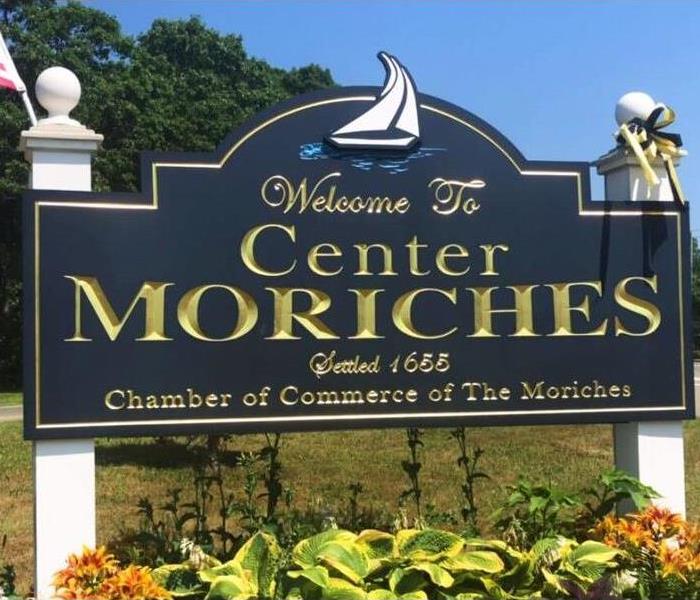 SERVPRO of the East End and Hamptons provides Center Moriches residents with water damage restoration services.
SERVPRO of the East End and Hamptons provides Center Moriches residents with water damage restoration services.
SERVPRO of the East End and Hamptons is available 24 hours a day for water damage restoration emergencies, large or small. When you are dealing with water damage, immediate action is crucial. A delay of just a few hours can greatly increase the severity of the water damage.
We Answer the Phone Ready to Help
Call Today - (631) 653-9595
We understand that when you call us, you may be feeling confused, stressed, and vulnerable. You need an expert to guide you through this crisis. SERVPRO of the East End and Hamptons has the specific water damage training and experience to help you through this tough time. We specialize in water damage restoration—in fact, it's the cornerstone of our business.
What to Expect
When you call, we will ask several questions regarding your water damage emergency. These questions will help us determine what equipment and resources to bring, including how many trained SERVPRO Professionals may be needed.
Our SERVPRO Representative will ask several questions:
- Your name and contact information
- Your insurance information (if applicable)
- The street address of the water-damaged home or business
- When did the flooding or water damage occur?
- What caused the water damage (if known)?
- Is there electricity available (on-site)?
About SERVPRO of the East End and Hamptons
SERVPRO of the East End and Hamptons specializes in the cleanup and restoration of residential and commercial property after a fire, smoke or water damage event. Our staff is highly trained in property damage restoration. From initial and ongoing training at SERVPRO’s corporate training facility to regular IICRC-industry certification, rest assured our staff is equipped with the knowledge to restore your property.
Initial Steps to Take After a Water Damage
2/4/2021 (Permalink)
Initial Steps to Take After a Water Damage
The initial steps to take after a water damage occurs are contacting your insurance company and your plumber for repair. Next, call the experts at SERVPRO of The East End and Hamptons, who are available 24/7 for your emergency needs! We will need to determine the type of water that has affected your home so we can start the cleanup and restoration process accordingly. Following a water damage, all affected materials and content will need to be removed or properly dried and disinfected.
The types/categories of water that are involved will be determined by some of the following:
Is it water from rain, condensation, leaky pipes, etc.?
Is it water from dishwashers, washing machines, toilets, etc.?
Is it water from sewage or serious flooding from nearby rivers, etc.? - This water can cause serious health problems.
Have you recently experienced water damage from a storm or flood?
9/28/2020 (Permalink)
Have you recently experienced water damage from a storm or flood?
On the East End of Long Island it doesn’t take much for our homes or businesses to experience water damage. Whether its from a seasonal storm, coastal flooding, or high tides and strong winds, it happens quickly. It can lead to damage that may not be apparent at first glance. While we might think that we can save money from cleaning it up ourselves, that choice often leads to more expensive repairs down the line.
Here’s why you need to call the professionals at SERVPRO of The East End and Hamptons after a storm or flood water damage:
Prompt Service and Professional Team
When dealing with a flooded home or business, timing is everything. Your main concern should be to avoid secondary water damage. This is why you need to bring in a professional restoration company. We will begin water cleanup and drying services within a quick and efficient time span. Our team has extensive experience, training and certifications in water damage cleanup and restoration.
Mildew and Mold Growth Prevention
Flood water and secondary water damage can provide a good breeding ground for mold and mildew. Our team will properly extract the water and develop a professional drying plan to avoid the growth of fungi and other microorganisms.
Have you recently experienced water damage from a storm or flood? Call SERVPRO of The East End and Hamptons at 631-653-9595 for more information.
The word "mold" can be scary for a homeowner.
7/31/2020 (Permalink)
The word "mold" can be scary for a homeowner.
Not only can it cause damage to your home, it can also be a potential health hazard to you and your family. Here are three warning signs that you shouldn't ignore:
1) Water spots
Any wet spot in your home can be a potential sign of mold growth. This may include water spots on your ceilings or walls, or on floors in your basement or crawlspace. If you find evidence of water spots, you need to find the source of moisture and have it taken care of immediately.
2) Discoloration
If you find a spot on a wall or floor that's discolored, it is a potential sign of mold. Discoloration that is green or black is a definite warning sign of mold growth. However, any discoloration can mean growth is present, even if it isn't of the tell-tale colors.
3) Bad smell
If you have mold growth in your home, it may cause a bad smell. Depending on the type and how much of it you have, it could be a very faint smell or it could be completely overwhelming. It can smell musty or earthy, or produce a more pungent odor. Any bad smell needs to be investigated and addressed.
Mold is not something to be ignored. If you experience any of the warning signs above, call the experts here at SERVPRO of The East End. Our trained and certified team is here to help. We have state of the art equipment and techniques to carry out mold remediation tasks of any size to keep your home safe and clean.
Using local services is useful in any size water damage.
7/7/2020 (Permalink)
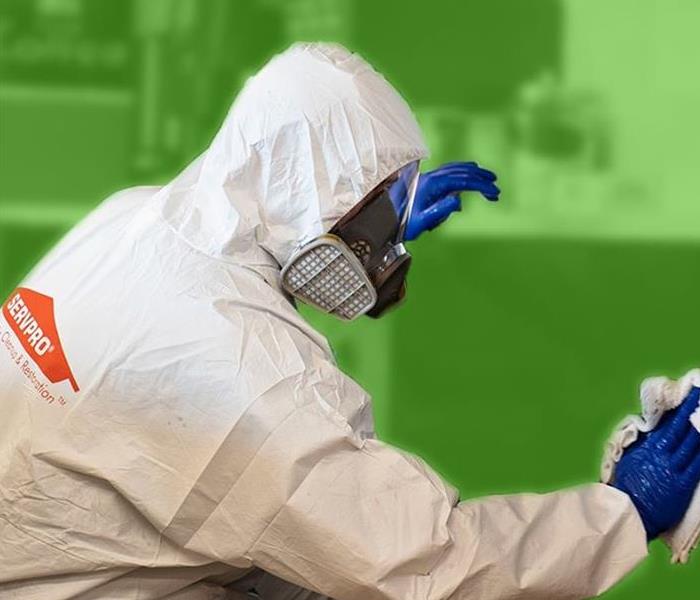 PPE (Personal Protective Equipment)
The safety of our team comes first!
PPE (Personal Protective Equipment)
The safety of our team comes first!
Using local services is useful in any size water damage.
SERVPRO of The East End has the resources to handle large scale cleanup and restoration as well as minor issues involving water damage. Requirements to remove water damage vary depending on the size and scale of the job at hand.
SERVPRO of The East End technicians are IICRC certified and trained to remove moisture from your home in the most efficient way possible. We provide personal protective equipment (PPE) to our team allowing them to enter a flooded property safely, even where contaminated materials like raw sewage may be present. A cleanup process and drying procedure is then established. We can work directly with your insurance company in most cases and will keep you informed every step of the way.
SERVPRO of The East End is available 24/7 for your emergency water damage needs! Give us a call for more information, (631) 653-9595.
Water damage can come from many different sources.
7/6/2020 (Permalink)
Water Damage
Water damage may be slow and minor such as water spots, that may eventually worsen, or it may be instantaneous and catastrophic such as flash flooding. However it occurs, water damage is a major contributor to property loss.
Causes
Water damage can come from many different sources such as: a broken dishwasher hose, a washing machine overflow, a leaky dishwasher, broken, frozen or leaking pipes, flood waters, or overflowing bathtubs and clogged toilets.
According to the Environmental Protection Agency, 13.7% of all water used in the home today can be attributed to plumbing leaks. On the average that is approximately 10,000 gallons of water per year wasted by leaks for each US home. A tiny, 1/8-inch crack in a pipe can release up to 250 gallons of water a day.
Experts suggest that homeowners inspect and replace worn pipe fittings and hose connections (to all household appliances that use water) at least once a year.
Have you experienced a water damage? Do you need cleanup and restoration services? SERVPRO of The East End is here to help, 631-653-9595.
5 easy tips to help prepare you in case of a water damage.
7/6/2020 (Permalink)
5 easy tips to help prepare you in case of a water damage:
- Check your insurance coverage. Most renter’s or homeowners insurance policies do not cover flooding, or even a sewer backup. Find out what coverage you do have.
- Keep a record of all of your belongings. Take photos and keep copies of receipts and other documents for more valuable items. Keep a copy of these records online, in a waterproof safe or at another location. If you do experience water damage, it can be easy to forget about certain belongings.
- Take precautions to limit the risk of water damage on your property by frequently checking pipes for leaks or weakness. Pay attention to any indicators that there might be water damage. These can be the sounds of dripping water in the walls, dark spots on the ceiling, or a significant change in your water bill.
- Set your home or business up so that it is at less risk of damage from heavy rains or flooding by ensuring that your roof is sound. Make sure there are no cracks in the foundation. Check that the landscaping around your property is sloped to direct water away from your foundation, rather than toward it.
- Find a professional, like SERVPRO of The East End, that you can trust and have their contact information handy.
There are different types of water that cause damage.
6/11/2020 (Permalink)
There are different types of water that cause damage to your home or business.
SERVPRO of The East End approaches and handles each water damage accordingly.
Regardless of the type of water that has caused the damage, there is always going to be a process of cleanup and restoration that we follow. We must first remove all of the moisture and damp items so that mold will not begin to grow.
Clean Water
Much like its name, water that is free of contaminants is considered “clean” and not the type to pose an immediate threat to your health. Examples of clean water types would be water from: broken water lines, appliances, toilet tanks etc.
Gray Water
In gray water, there were be a slight amount of contaminants, and water damage cleanup and restoration from this type of water becomes a bit more complicated. It may pose a health risk, due to the fact that it will contain chemical or biological contamination.
Gray water will likely be the type of water that comes from: dishwashers, aquariums, showers, etc. Gray water can turn into black water if not treated.
Black Water
Black water is a serious matter and the most hazardous of the three classifications because it is considered highly contaminated by harmful chemicals and biological matter. This type of water includes: floodwaters containing soil and all sewage waters.
Water Damage Tips
3/19/2020 (Permalink)
Water Damage Tips
Plumbing issues
Water damage is often caused by plumbing issues. It’s important to inspect the plumbing systems on your property at least once a year to ensure that there aren’t any problems with hoses or pipe joints. If your water bill is unusually high, that might be an indication of an undetected leak.
Washing machine leaks
Unless you’re doing laundry, you probably don’t think twice about your washing machine. But if it breaks down, the results could be catastrophic. For example, if the supply hose is damaged or has a faulty connection to the wall or washing machine, more than 600 gallons of water could potentially spill out within an hour. Take care of your washing machine and your washing machine will take care of you.
Aging water heaters
Water heaters have a shelf life. You can wait until your water heater starts leaking to replace it. But if you’re being proactive about avoiding water damage, you should replace it every 10 years. A tank-less water heater can last for as many as 20 years.
Inclement weather
If your property isn’t weatherproof, a bad snowstorm or rainstorm could damage your roof, walls and ceiling. Make sure your property is ready for inclement weather by ensuring that your rain gutters and downspouts are clean. Inspect roofs annually.
SERVPRO of The East End
For as many precautions as property owners can take to prevent water damage, they still occur. SERVPRO of The East End is here to help!
Why You Need to Call A Water Damage Restoration Professional After A Flood
8/21/2019 (Permalink)
On the East End of Long Island it doesn’t take much for our homes or businesses to experience water damage from seasonal storms, coastal flooding, high tides and strong winds. It happens quickly, often and can have far reaching effects that may not always be apparent at first glance. While we might like to think we can save money from cleaning it up ourselves, that choice often leads to more expensive repairs down the line.
Here’s why you need to call in the professionals to clean up after your water damage:
Prompt restoration services
When dealing with a flooded home or business, timing is everything. Your main concern should be to avoid secondary water damage. This is why you need to bring in a professional restoration company. We will conduct mitigation, water cleanup and drying services within a quick and efficient time span. This is because we have extensive experience, training and certification in water damage restoration. Our professionals will send multiple crew members to the site to get the work done in the shortest amount of time possible. We will also get to the root cause of the water in the home or business. If it is a supply line break or a pipe break, we will bring our plumbing partners in as well.
Mildew and Mold growth prevention
Flooded water and secondary water damage may provide a good breeding ground for mold and mildew. Flood damage mitigation professionals will conduct drying to avoid the growth of fungi and other harmful microorganisms. If mold is already present, we will use grade cleaner and disinfectants to eliminate the mold. This will prevent exposure to the mold and mold growth, which can affect your health.
Holistic help
A Water restoration company offers more than drying and water cleanup services. Our services are holistic and beneficial to the home or business owner. A flooded property comes with other issues that are subject to the flood damage. We also offer additional services such as deodorization, vent cleaning, sanitation, and content restoration. Our main objective is to restore your property to its previous condition prior to water in the home or water in the business damage. Very often, our customers have commented their property looks even better after our services than it did before. We do our best to make all of our customers happy each and every time.
Have you recently experienced water damage from a storm or flood? Call SERVPRO of The East End at 631-653-9595 for more information or to come assess the damage you may have on your property.
How to Get Rid of Carpet Odor from Water Damage
7/29/2019 (Permalink)
 SERVPRO of The East End will have your carpets smelling fresh as clean to remove those musty smells from water damage.
SERVPRO of The East End will have your carpets smelling fresh as clean to remove those musty smells from water damage.
Whether your home is completely covered in wall-to-wall carpeting, or you have opted just to carpet specific rooms in your house such as the bedrooms or the playroom, keeping those carpets clean and odor-free can sometimes be a challenge. Especially if you’ve suffered any kind of water damage.
Even the slightest bit of water can transform your once pristine, odor-less carpet into a hotbed of musty smells reminiscent of a high school locker room.
Following are a few conditions that may cause odors along with some useful information on how to eliminate those odors.
It Doesn't Take a Flood to Cause Carpet Odor
If you have ever experienced water damage, you know how important it is to contact water damage remediation professionals like SERVPRO of The East End quickly! With our training, expertise and equipment, we can quickly remove the water and moisture from the air, as well as start drying any carpets and rugs that may have gotten soaked. After 24-48 hours, water damage may become worse as mold begins to grow and destroy the drywall, carpets, framing, furniture, clothes, and beyond. This kind of mold damage is the worst-case scenario and will usually result in the carpeting needing to be replaced.
In scenarios where your carpeting has a musty odor, there may be a chance of getting rid of the smell and saving your carpets from further damage. Unlike the scene above where the carpeting is completely flooded and soaked, in most situations with carpet odor, there isn't any visible water damage. There isn't water dripping down a wall or a wet carpet or a drip from the ceiling pooling on your carpet. Sometimes the carpet odor may be caused by someone spilling a cup of water or moisture from the basement floor underneath the rug. Even forgetting to hang up your bath mat after taking a bath can lead to a musty carpet odor from the bath mat.
Why Does My Carpet Smell?
If you're paying attention, you may have noticed a constant in each of the scenarios we've discussed above. The constant is water whether it's from a dripping towel, a spilled cup, or condensation dripping off a water pipe. If your carpets get wet and are not dried quickly, they may start to smell. Going back to the bathroom, think about a damp towel. If you throw the damp towel into a pile on the ground, it may become musty after a day or two. But if you hang it up to dry, it will usually be fine the next time you use it.
The same goes for your carpet. If the water and moisture in the carpet are not able to evaporate quickly and dry out, then it may become musty and smelly. The musty smell from your carpet is a strong indicator that mold or mildew is growing within it. If it is not treated, it can lead to premature decay and deterioration of your carpet and sub floor.
How Do I Get Rid of the Odor and the Causes of It?
If you smell an odor coming from a carpet, you can take a few steps to get rid of the odor. The first step is to absorb any excess water with a cloth or paper towel. Then open the windows or doors around the carpet to get fresh air circulating. You can then take some baking soda and apply it to the smelly area. The baking soda absorbs odors and is usually harmless to carpets. Vacuum up the baking soda after letting it sit for a day.
If the odor persists, you can try a mixture of water and vinegar to try to eliminate the odor. Start with a mixture of one part distilled white vinegar to two parts water. You don't need to saturate the smelly area; you simply need to spray a fine mist over it and let it dry. This technique also works for fabrics like sofas and drapes.
If the Odor Persists, Call the Professionals
Ultimately, the most effective way to get rid of carpet odors from water and mold damage is to contact SERVPRO of The East End. We have the tools, the technicians and the equipment to extract the water, dehumidify the air, and remove the odors from your carpet, carpet pads, sub floors, drywall, and framing. If you've tried everything to get rid of the odors and they keep coming back or are getting worse, you can trust SERVPRO of The East End. We will not only get rid of the odor, but we will find and address the source so that it doesn't happen again. Give us a call for all of your water, mold, and fire damage restoration needs. 631-653-9595. SERVPRO of The East End will also provide a thorough seasonal cleaning of your carpets, upholstery and drapes prior to any damage being done.
SERVPRO of The East End Mitigates Water Damage Quickly & Efficiently
7/16/2019 (Permalink)
Water spills can quickly escalate, causing severe harm to the contents and structure of your property. If that isn’t enough to scare you, microbial presence in water can create health concerns for people and pets in the home or lead to more extensive mold remediation requirements further down the line. Acting quickly in the wake of a burst pipe or attic leak is essential to containing potential damages. A professional service with highly trained technicians could help to mitigate losses and avoid expensive replacements.
Requirements to remove water damage can vary depending on the size and scale of the job at hand. However, using local services is useful in any size disaster because they reduce call-out times. SERVPRO of The East End has the resources to deal with larger scale restoration as well as minor issues involving water. Our technicians are IICRC certified and trained to act quickly to remove moisture from your home, mitigating against costly permanent harm to structure or contents.
Restorers working on a clean water emergency can enter your property, remove debris, possessions and conduct vital safety checks. These checks could include: alerting you to loose wiring, weakness in floors or ceiling as well as potential contamination hazards. SERVPRO of The East End provides personal protective equipment (PPE) to staff members allowing them to enter a flooded property safely, even where contaminated materials like raw sewage may be present.
A proper drying procedure needs establishing in the advent of a clean water emergency. If large amounts of water have migrated, we might set up smaller drying zones using physical barriers like plastic sheeting. These zones allow us to concentrate our drying efforts resulting in a smarter, more efficient service. Where large quantities of water are present throughout the home, SERVPRO of The East End mobilizes submersible gas powered pumps that transport water to nearby open sewer points. Once standing water levels drop below two inches, we can bring in water extraction units for targeted removal of residual moisture and pooling.
Our local service has access to national resources in the restoration of water-related property damages, contact SERVPRO of The East End at (631) 653-9595 for more information.
Knowing Where Your Water Shut Off Valve Is Can Prevent Damage
2/11/2019 (Permalink)
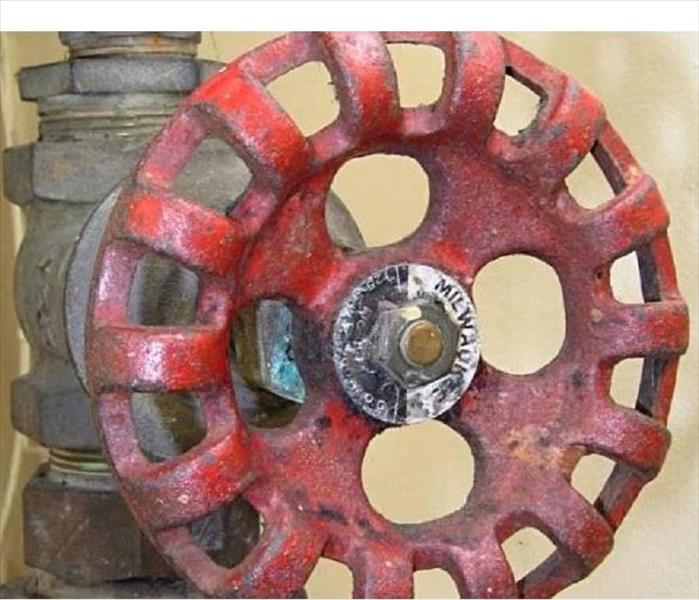 Photo by Michael Pereckas
Photo by Michael Pereckas
Knowing how and where to shut off your home's water supply is as important as knowing how and where to turn-off or reset an electric breaker or replace a fuse.
Every home is required to have a main water shut-off valve installed during its initial construction. For most emergencies, shutting-off the proper inside valve is a crucial first step to preventing more damage.
Basements:
The shut-off valve is typically located near the front foundation wall. The main water supply may come through the concrete floor or through the wall. The valve is typically within 3-5 feet of where the main water supply enters. In some cases, the main water supply may enter in a different area, like a laundry room, or up through the floor, near the water heater or furnace.
Crawl Space and Basement
The shut-off valve may be where the water enters the basement or in some older homes, the shut-off may be inside the crawl space. If the latter is true, you may want to consider a secondary valve located in the basement.
Crawl Space with No Basement
The shut-off valve will typically be located near the water heater or under the kitchen sink, but anywhere is possible. As with a situation where there are a crawlspace and a basement, the valve may be inside a crawlspace; in which case, you may want to consider a secondary valve located up in the living space (near the water heater or under a sink).
Slab-On-Grade Construction
The shut-off valve will typically be located near the water heater or under the kitchen sink, but, again, it could be anywhere. It is important you know exactly where it is so you can be quick to turning it off in an emergency. Once you know where it is, you may want to tag it. Let your family members know where it is, and how to properly shut it off during a water emergency.
Water Damage in Your Attic
2/8/2019 (Permalink)
The attic is much like a basement in that it is an area of a house that may largely be ignored for extended periods of time. Stains, mold and wet or swollen installation are signs of a leak in the attic. If your roof has cracked, curled, or is missing shingles, damaged flashing and/or signs of wind/rain damage, it may be vulnerable to leaks, which could result in water damage. Weather in colder climates may also cause ice dams to develop on the roof, which can then leak into the attic when snow and ice melt. To try and prevent water damage coming in through your attic, pay attention to possible problem areas, including around roof vents and chimneys, the flashing (where the roof connects with the walls) and the valleys (where two roof planes connect).
If you ever do detect water damage in your attic, call SERVPRO of The East End to dry the clean and the area thereby preventing secondary water damage like mold. We can be reached at 631-653-9595 24 hours a day, 7 days a week, 365 days a year.
The Top 5 Reasons for Water Damage
2/6/2019 (Permalink)
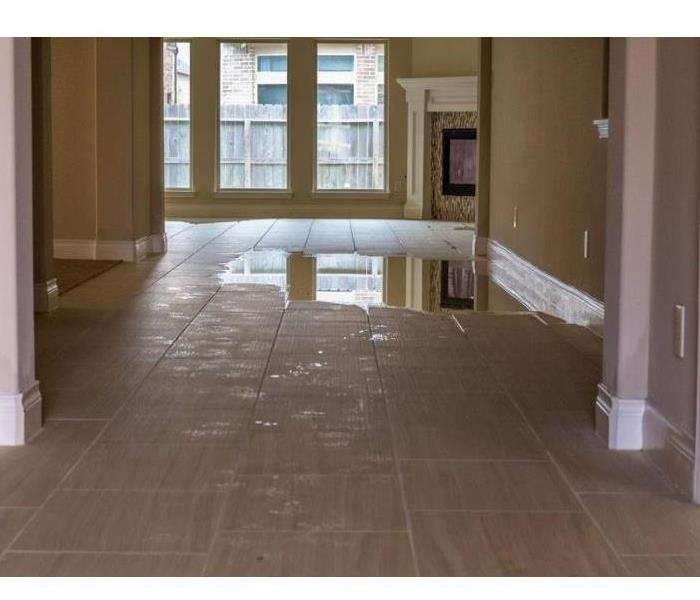 By regularly taking a few precautions, you may be able to prevent costly water damages.
By regularly taking a few precautions, you may be able to prevent costly water damages.
Discovering that your property is destroyed by a leak or a flood can be devastating, and repairing water-damaged walls and floors is often very expensive. Water damage and frozen pipes are the third most common reason for property owners to file insurance claims, with damages averaging at approximately $8,000.00 per claim.
The good news is that most water damages can be prevented. By looking out for plumbing problems, leaks and other issues you may be able to prevent water from destroying your property.
Plumbing issues
Water damage is often caused by plumbing issues. That’s why it’s important to inspect the plumbing systems on your property at least once a year to ensure that there aren’t any problems with hoses or pipe joints. You should also keep in mind that plumbing pipes have a long lifespan. Brass pipes can last for as many as 70 years while copper pipes can last for more than 50 years. The average lifespan for galvanized steel pipes is often between 20 and 50 years.
Drain pipes are usually made of either cast iron (which can last for as many as 100 years) or polyvinyl chloride (PVC). Properly maintained PVC pipes can last indefinitely. Check your home inspection report or consult a licensed plumber to learn about the lifespan of the plumbing pipes in your home.
If your water bill is unusually high, that might be an indication of an undetected leak. Purchasing a water leak sensor that sends alerts to your phone is one way to safeguard your property. You should also check around your toilets, tubs, showers and sinks for any soft spots or moisture. Keep an eye out for loose tiles as well. If you have a dishwasher or a refrigerator with a water line, look for warped or discolored floorboards.
Washing machine leaks
Unless you’re doing laundry, you probably don’t think twice about your washing machine. But if it breaks down, the results could be catastrophic. For example, if the supply hose is damaged or has a faulty connection to the wall or washing machine, more than 600 gallons of water could potentially spill out within an hour. That could lead to significant water damage, especially if your washing machine is located on the second floor of your home.
To prevent water damage, you should replace your washing machine supply hose at least once every five years. Also, resist the temptation to overload your washing machine. Bu constantly overloading your washing machine, you could loosen gaskets and valves or cause cracks. Take care of your washing machine and your washing machine will take care of you.
Bursting water pipes
During severely cold winters, pipes can freeze and burst. This is more likely to happen if you have certain types of pipes, such as swimming pool supply lines, water sprinkler lines and pipes with minimal insulation that run against exterior walls.
If temperatures often freeze in your area, as they do in ours, be sure to protect your pipes. Insulate both hot and cold water pipes using heat tape or pipe sleeves available in your home improvement store. If you have water supply lines in your garage, keep the garage door closed as often as possible. Open kitchen and bathroom cabinet doors to allow warmer air to circulate. If you plan to spend some time away from your property, leave the heat on and set your thermostat to at least 55 degrees. You can’t control the weather, but you can do your best to prepare for it.
Aging water heaters
Water heaters have a shelf life. You can wait until your water heater starts leaking to replace it. But if you’re being proactive about avoiding water damage, you should replace it every 10 years. A tankless water heater can last for as many as 20 years.
You can find out how old your water heater is by looking up the serial number on the manufacturer’s sticker near the top of the water heater. Make sure to regularly inspect your water heater to check for signs of moisture build-up, mold or corrosion. If your water isn’t as hot as it used to be or there’s rust coming from your faucets, it’s time to call a plumber or water heater specialist.
Inclement weather
Snow may look beautiful. But if your property isn’t weatherproof, a bad snowstorm could damage your roof, walls and ceiling. Make sure your property is ready for inclement weather by ensuring that your rain gutters and downspouts are clean. You should also check doors and windows to ensure that your caulking hasn’t cracked.
If it snows where you live, be wary about the formation of ice dams on your roof. This happens when the heat inside your home causes water to melt in the middle of your roof. The water then refreezes near the edges, forming a dam that prevents melting snow from draining off the roof. The water that backs up can leak into your property and damage ceilings, walls and other areas of your home. To prevent ice dams from forming, insulate your attic to keep heat from rising and reaching the roof.
Inspect roofs annually. Professional roof contractors look for exterior and interior warning signs that your roof’s condition may lead to water damage, including cracked or missing shingles and areas where water is prone to pool. An inspection may cost several hundred dollars, but can save you thousands in damages, as well as providing peace of mind which no one can put a dollar amount on.
SERVPRO of The East End
For as many precautions as property owners can take to prevent water damage, water damages still occur. At SERVPRO of The East End, we have been in the business of mitigating water damage, fire damage, mold issues and more for over 40 years. Our IICRC trained and certified team are available 24/7 to be 'Faster to any size disaster' and we will make it "Like it never even happened." Give us a call at 631-653-9595 to discuss your cleaning and restoration issues at any time you need our help.
What To Do After a Water Damage
12/7/2018 (Permalink)
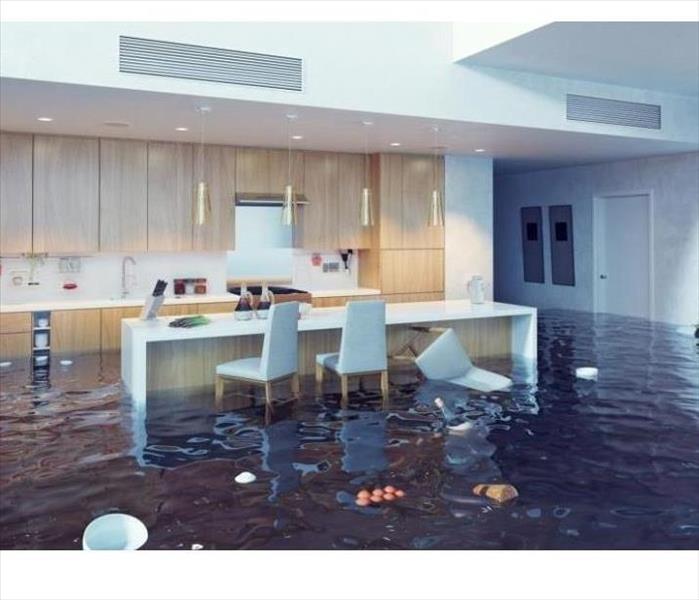 A little knowledge can go a long way in preventing serious water damage. Learn the precautions you should take to avoid major damage.
A little knowledge can go a long way in preventing serious water damage. Learn the precautions you should take to avoid major damage.
No one wants to come home to a flooded basement or to wake up to the sound of a broken pipe spraying water on valuable furniture and household possessions. However, the possibility of water damages occurring in your home or business is very real. Whether it is pipe damage or a weather-related issue that is the cause, it is important to arm yourself with basic knowledge in order to best deal with this type of emergency before it happens. Here are a few tips to help in the event of water damage in your home:
- First, determine whether it safe to stay in the house
- Make sure there are no active electrical devices or outlets immersed in or near the water
- Note that wet floors are slippery and “slip and fall” hazards are some of the most prevalent concerns
- Keep in mind that wet materials can be VERY heavy
- Have a plumber’s phone number ready and available
- Contact SERVPRO of The East End (631-653-9595) for complete restoration
While waiting for SERVPRO of The East End to arrive, here is what you CAN do:
- Shut off the water
- Remove excess water by mopping and blotting
- Wipe excess water from wood furniture after removal of lamps and tabletop items
- Remove and prop wet upholstery and cushions
- Place aluminum foil or wood blocks between furniture legs and wet carpeting
- Turn air conditioning on for maximum drying in the summer
- Remove colored rugs from wet carpeting
- Remove art objects and other prized possessions to a safe, dry place
- Gather loose items from floors
What NOT to do After Flooding:
- Don't leave wet fabrics in place. Hang furs and leather goods
- Don't leave books, magazines or other colored items on wet carpet or floors
- Don't use your household vacuum to remove water
- Don't use television or other household appliances
- Don't turn on ceiling fixtures if ceiling is wet, and keep out of rooms where ceilings are sagging
Never try to fix a broken pipe by using tape or plumbing putty. Broken pipes are a serious problem, which should be handled by a professional. SERVPRO of The East End is on call 24/7 to help home and business owners with complete cleanup. Our goal is to help you regain control and repair any damage, “Like it never even happened”. Call us at 631-653-9595.
Humidity Causes Water Damage in Trailers
10/26/2018 (Permalink)
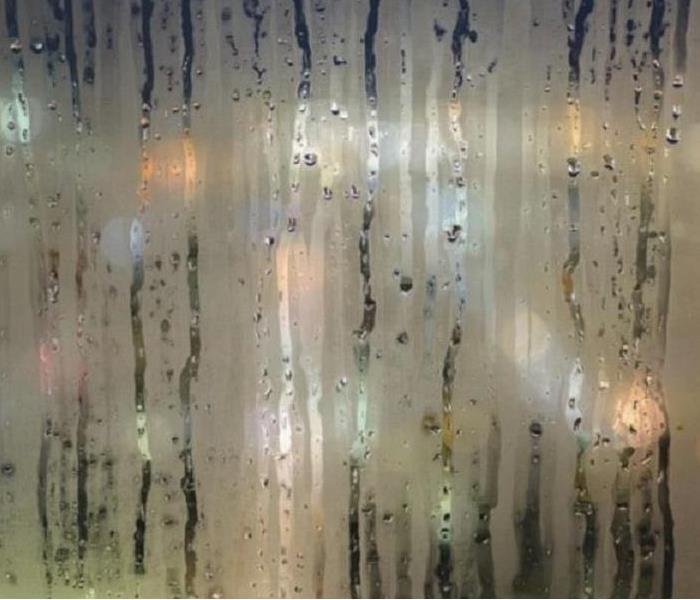 Condensation buildups in trailers may cause serious water damage, if not addressed at an early stage.
Condensation buildups in trailers may cause serious water damage, if not addressed at an early stage.
If things are getting steamy in your RV, you would be wise to find a solution, sooner than later.
Whether you’re camping out in the summer or winter, travelling, or if you live in your trailer year round, humidity inside your trailer can cause serious problems that lead to structural damage and health issues.
Humidity rises when the temperature changes and when you’re cooking, showering, or washing. Even your breathing at night can raise humidity levels in small enclosed spaces. In each of these cases, water vapor is released into the air. When vapor cools, condensation forms. The condensation clings to windows, settles on walls, and may even seep between joints.
If you don’t have a way to reduce the humidity; mold and mildew will form and metal structures can corrode — posing serious health risks for you and your family and reducing the life of your vehicle. Mold and mildew create a nasty smell and ruin upholstery. If the issue continues, you could end up with a termite infestation or other pests.
As an RV owner, it’s essential that you stay on top of the moisture issue.
How to Control RV Humidity Problems
In the summer, you can easily control moisture in your motor home by using an air conditioner or by increasing ventilation from opening windows. But in cooler months that’s usually not the best solution for staying warm and comfortable.
For most recreational vehicles, the best solution is a dehumidifier. Dehumidifiers circulate air and pull out water, without changing the air temperature. Water is extracted and collected, and dry air is returned. Dehumidifiers work quickly, too — you’ll notice a difference in humidity within a few minutes.
What’s the Best Dehumidifier for an RV?
Don’t use the same dehumidifier for your trailer as you would for your house. The best dehumidifiers for recreational vehicles are small enough for your limited space and won’t be so noisy that you can’t sleep at night.
You have several types of dehumidifiers to choose for your motor home:
- Non-electric — silent operation, lower capacity for pulling moisture
- Electric with compressor — high capacity, some noise
- Electric with Peltier thermal technology — high capacity, lower power consumption, quieter than compressors
Be sure to do your research and read reviews to determine what option will fit your needs best.
Beating Humidity in Storage
Mold and mildew can also grow in your recreational vehicle while it’s in storage. Covering your RV in tarps and plastic is a good preventive measure, but it also traps moisture inside. Over the course of the winter, water vapor buildup can cause mold, and you’ll have a nasty surprise waiting for you come spring.
Ventilation is the best way to prevent moisture problems when your RV is in storage. Air vent covers allow you to keep the vents open on your motor home while protecting it from foul weather. Water vapor can escape and your RV’s interior stays dry.
You should also consider using an RV cover that is specifically made for trailers. The fabric of an RV cover is waterproof and breathable to ensure water vapor doesn’t build up.
Whether you’re camping, storing your recreational vehicle, or living in it year round, protecting it against excessive humidity will help guarantee many years of worry-free adventure and memories you’ll treasure for a lifetime.
And if you do require help in remediating water or storm damage, mold or pest infestations, call SERVPRO of The East End at 631-653-9595 to mitigate the problem and make it ‘Like it never even happened.’
5 Easy Tips to Prepare for Water Damage
9/12/2018 (Permalink)
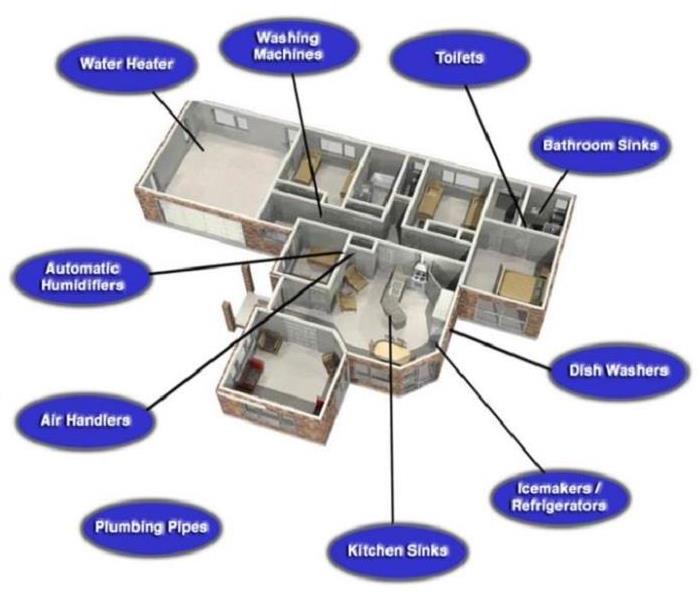 Water Damage Season is upon us and can cause serious property damage through any number of sources if we are not prepared.
Water Damage Season is upon us and can cause serious property damage through any number of sources if we are not prepared.
Water damage can happen in many different ways, and through many different sources. The better prepared you are, the less damage you will experience.
Water damage in your home or in your place of business does not need to be a traumatic experience.
Consider these 5 easy tips to better prepare.
- Check your insurance coverage. Most renter’s or homeowners insurance policies do not cover flooding, or even a sewer backup. Find out what coverage you do have.
- Keep a record of all of your belongings. Take photos and keep copies of receipts and other documents for more valuable items. Keep a copy of these records online, in a waterproof safe or at another location. If you do experience water damage, it can be easy to forget about certain belongings.
- Take precautions to limit the risk of water damage on your property by frequently checking pipes for leaks or weakness. Pay attention to any indicators that there might be water damage. These can be the sounds of dripping water in the walls, dark spots on the ceiling, or a significant change in your water bill.
- Set your home or business up so that it is at less risk of damage from heavy rains or flooding by ensuring that your roof is sound. Make sure there are no cracks in the foundation. Check that the landscaping around your property is sloped to direct water away from your foundation, rather than toward it.
- Find a professional you can trust. Water damage can be overwhelming, and you don’t want to be desperately searching for a water restoration expert at 3 AM when the pipes break.
About SERVPRO of The East End
SERVPRO of The East End specializes in the cleanup and restoration of residential and commercial property after a fire, smoke or water damage event. Our staff is IICRC trained and certified in property damage restoration. From the initial and ongoing training at SERVPRO’s corporate training facility to regular IICRC-industry certification, our staff is equipped with the knowledge, experience, equipment and expertise to restore your property to 'Like it never even happened'. And we are on call 24/7 for all of your emergency needs.
For more information call us at 631-653-9595. Like us on social media, or visit our website: SERVPROeastend.com.
Common Laundry Mistakes That May Cause Water Damage
2/15/2018 (Permalink)
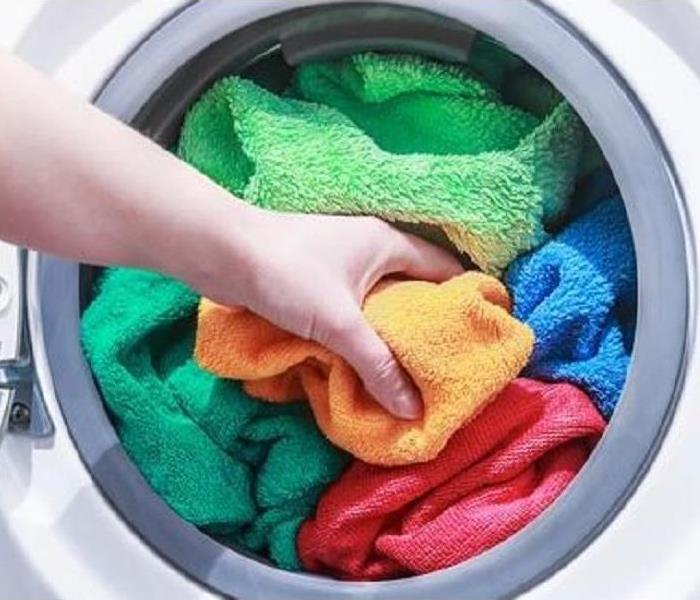 Overloading the drum of your clothes washer could lead to water damage
Overloading the drum of your clothes washer could lead to water damage
Having a clothes washer in your East End home is usually a given. However there is a downside to having a washing machine in your house – like any machine, they can break down, and if they break down, there is a risk of leaks. Leaks in your home means water damage which can often lead to mold. You want to avoid leaks, if possible. Here are some common laundry mistakes that harm your machine and increase the chance of a breakdown.
Metal items are a leading cause of washer breakdown – and that means more risk of water damage in your home. The three most common culprits are:
- Coins – always check the pockets of every item for coins before starting your washer.
- Zippers – you cannot remove zippers from your clothes, but you can zip them all the way up to the top, so they do not flap around as much.
- Brassieres – underwire and clasps on lingerie might cause damage. You can protect your washer by placing underthings in a mesh laundry bag.
Another thing that causes washer damage is over-filling the drum. It is tempting when you have several loads of laundry to stuff as much in as you can. Unfortunately, putting too many clothes in the machine puts extra stress on the workings. SERVPRO of The East End recommends checking out the manufacturer’s guidelines about weight.
Power surges present another potentially dangerous situation. A sudden spike of electricity can harm your washer, including melting its plastic components. Protect your machine by using a surge protector, and by unplugging when not in use.
No matter how careful you are, it doesn't always prevent leaks. In the event of water damage, SERVPRO of The East End is here to extract water, dry out carpets, baseboards, and floors and restore your laundry room and any other affected areas of your home as soon as possible. Our IICRC trained and certified technicians have the expertise, knowledge, equipment and drive to restore your damage to "Like it never even happened."
For help with water damage in your East End home, call SERVPRO of The East End at 631-653-9595.
What Happens When Water Damage Is Left Untreated?
2/15/2018 (Permalink)
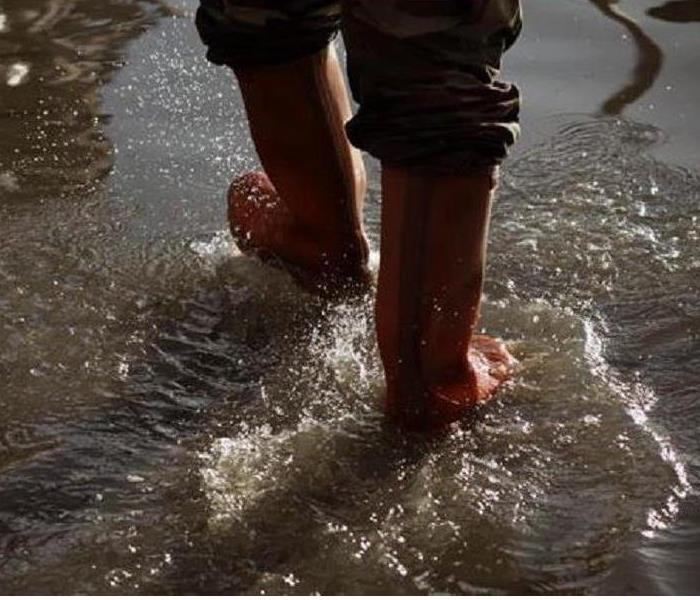 Left untreated for any length of time, water damage will continue to create a multitude of damages
Left untreated for any length of time, water damage will continue to create a multitude of damages
What Happens When Water Damage is Left Untreated? Following is a timeline detailing why you don't wan't to hesitate to make that call:
Water Damage Timeline
Within Minutes
- Water quickly spreads throughout your property, saturating everything in its path.
- Water is absorbed into walls, floors, upholstery, and belongings.
- Furniture finishes may bleed, causing permanent staining on carpets.
- Photographs, books, and other paper goods start to swell and warp.
Hours 1 - 24:
- Drywall begins to swell and break down.
- Metal surfaces begin to tarnish.
- Furniture begins to swell and crack.
- Dyes and inks from cloth and paper goods spread and stain.
- A musty odor appears.
48 Hours to 1 Week:
- Mold and mildew may grow and spread.
- Doors, windows, and studs swell and warp.
- Metal begins to rust and corrode.
- Furniture warps and shows signs of mold.
- Paint begins to blister.
- Wood flooring swells and warps.
- Serious biohazard contamination is possible.
More Than 1 Week:
- Restoration time and costs increase dramatically; replacing contaminated materials and structural rebuilding may be extensive.
- Structural safety, mold growth, and biohazard contaminants pose serious risks to occupants.
About SERVPRO of The East End
SERVPRO of The East End specializes in the cleanup and restoration of residential and commercial property after a fire, smoke or water damage event. Our staff is IICRC trained and certified in property damage restoration. From the initial and ongoing training at SERVPRO’s corporate training facility to regular IICRC-industry certification, rest assured our staff is equipped with the knowledge, experience, equipment and expertise to restore your property to 'Like it never even happened'.
Top Causes for Water Damage
2/9/2018 (Permalink)
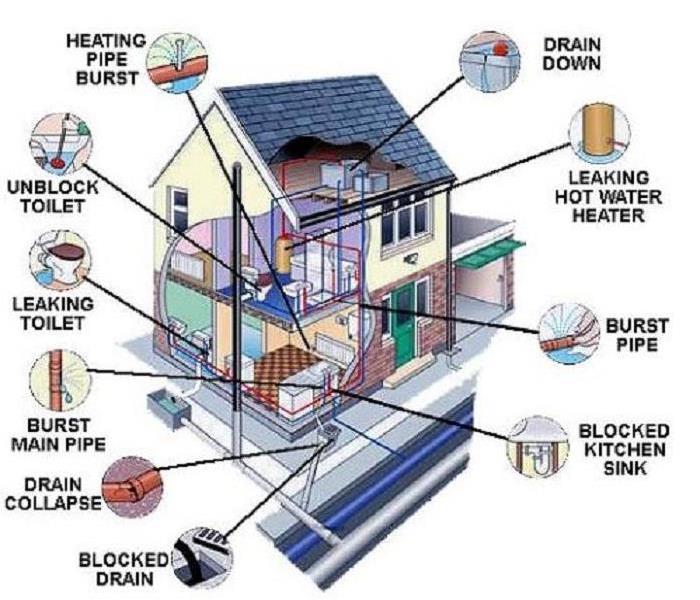 Water damages may occur through any number of hidden sources in the home.
Water damages may occur through any number of hidden sources in the home.
Water damage describes a large number of possible losses caused by water intruding where it will enable attack of a material or system by destructive processes such as rotting wood, growth, rusting metal, de-laminating of materials such as plywood, among others.
The damage may be imperceptibly slow and minor such as water spots, that may eventually mar a surface, or it may be instantaneous and catastrophic such as flooding. However fast it occurs, water damage is a major contributor to property loss.
Causes
Water damage can originate through different sources such as a broken dishwasher hose, a washing machine overflow, a leaky dishwasher, broken, frozen or leaking pipes, flood waters, overflowing bathtubs and clogged toilets.
According to the Environmental Protection Agency, 13.7% of all water used in the home today can be attributed to plumbing leaks.On the average that is approximately 10,000 gallons of water per year wasted by leaks for each US home. A tiny, 1/8-inch crack in a pipe can release up to 250 gallons of water a day.
According to Claims Magazine (August 2000), broken water pipes ranked second to hurricanes in terms of both the number of homes damaged and the amount of claims filed. Experts suggest that homeowners inspect and replace worn pipe fittings and hose connections (to all household appliances that use water) at least once a year. This includes washing machines, dishwashers, kitchen sinks and bathroom lavatories, refrigerator ice makers, water softeners and humidifiers.
In the event that you do suffer from water damages, SERVPRO of The East End can be there 'Faster to any size disaster' to remediate the damage to 'Like it never even happened'. Contact us at 631-653-9595 to discuss your needs.
source: wikipedia
SERVPRO of The East End is Faster to Your East End Water Damage Event
12/28/2017 (Permalink)
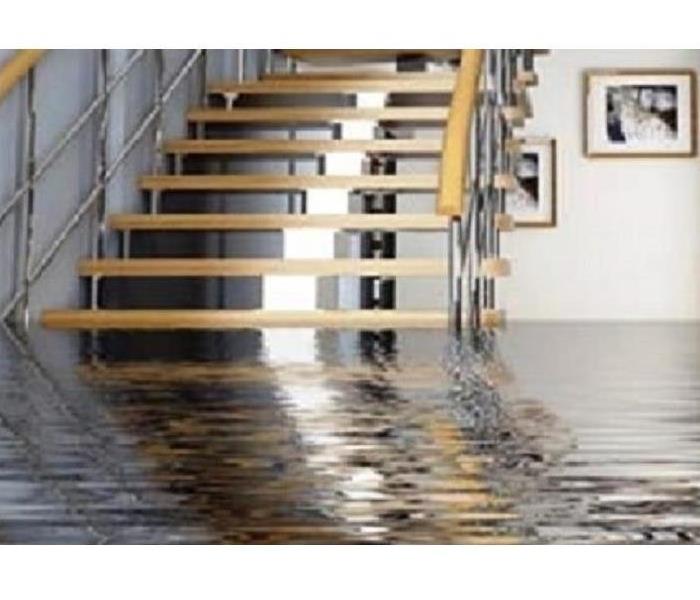 SERVPRO of The East End provides 24 hour fire and water damage restoration service on the East End of Long Island, New York.
SERVPRO of The East End provides 24 hour fire and water damage restoration service on the East End of Long Island, New York.
Flooding and water emergencies don’t wait for regular business hours and neither do we. SERVPRO of The East End provides emergency cleaning and restoration services 24 hours a day, 7 days a week, including All Holidays.
Faster To Any Size Disaster
Flooding and water damage is very invasive. Water quickly spreads throughout your home or business and gets absorbed into floors, walls, furniture, and more. SERVPRO of The East End arrives quickly and starts the water extraction process almost immediately. This immediate response helps to minimize the damage and the cleaning and restoration costs.
Need Emergency Service? Call Us 24/7 – at 631-653-9595
Water Damage Timeline
Within Minutes
- Water quickly spreads throughout your property, saturating everything in its path.
- Water is absorbed into walls, floors, upholstery, and belongings.
- Furniture finishes may bleed, causing permanent staining on carpets.
- Photographs, books, and other paper goods start to swell and warp.
Hours 1 - 24:
- Drywall begins to swell and break down.
- Metal surfaces begin to tarnish.
- Furniture begins to swell and crack.
- Dyes and inks from cloth and paper goods spread and stain.
- A musty odor appears.
48 Hours to 1 Week:
- Mold and mildew may grow and spread.
- Doors, windows, and studs swell and warp.
- Metal begins to rust and corrode.
- Furniture warps and shows signs of mold.
- Paint begins to blister.
- Wood flooring swells and warps.
- Serious biohazard contamination is possible.
More Than 1 Week:
- Restoration time and cost increase dramatically; replacing contaminated materials and structural rebuilding may be extensive.
- Structural safety, mold growth, and biohazard contaminants pose serious risks to occupants.
About SERVPRO of The East End:
SERVPRO of The East End specializes in the cleanup and restoration of residential and commercial property after a fire, smoke or water damage event. Our staff is highly trained in property damage restoration. From initial and ongoing training at SERVPRO’s corporate training facility to regular IICRC-industry certification, our staff is equipped with the knowledge and expertise to restore your property.
Certifications
- CCT - Carpet Cleaning Technician
- ASD - Applied Structural Drying Technician
- ECTP - Employee Certification Training Program
- WRT - Water Damage Restoration Technician
- HST - Health and safety Technician
- FSRT - Fire & Smoke Damage Restoration Technician
- IICRC Certified Firm
- RRRP - Lead-Based Paint Activities and Renovation
We Specialize in Flooded Basement Cleanup and Restoration
12/28/2017 (Permalink)
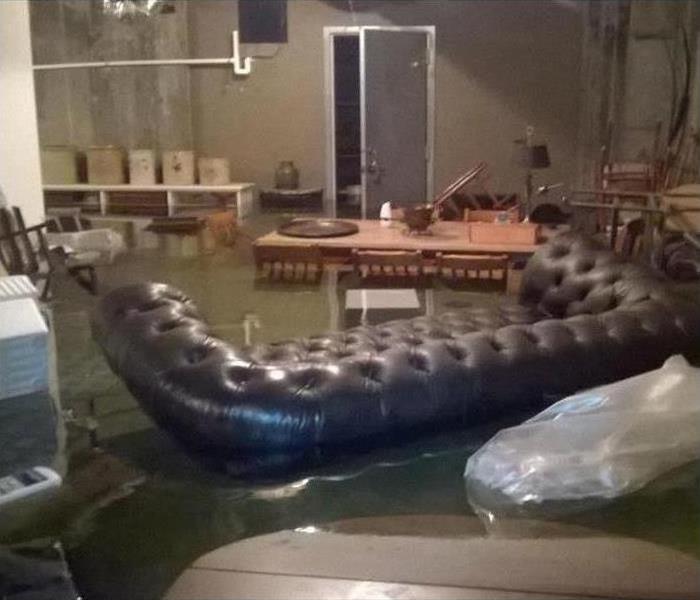 This Amagansett basement flood was the result of a broken pipe. The water stood approximately two and a half feet when we arrived.
This Amagansett basement flood was the result of a broken pipe. The water stood approximately two and a half feet when we arrived.
A basement can flood at any time, although flooding most often occurs during heavy rainfall. Basements are inherently prone to flooding because they are the lowest level of a building and are normally built partly or entirely below ground level.
There are a number of reasons why basement could flood, including:
- A blocked or failed sewer lateral pipe
- Heavy rain causes surface water to pool around your home
- Storm sewer backup
- Sanitary sewer backup
- Foundation drainage failure
- Water supply-line break or hot-water tank failure
- And many more
Have Questions about Basement Flooding?
Call SERVPRO of The East End today at 631-653-9595
If flood water is not handled quickly and properly, it can jeopardize your health and safety, and cause severe damage to your home’s structure. Remember, the longer you wait, the worse the problem will get.
The bottom line: a flooded basement can jeopardize your health, safety, and your home’s integrity. It’s worth making a call to SERVPRO of The East End and let our trained, professional crews handle the situation safely and correctly. We have earned the trust of hundreds of homeowners, business owners, and property professionals.
We are Flooded Basement Specialists:
- We are Available 24 hours/7 days per week/365 day a year
- We’re a Preferred Vendor to many National Insurance Companies
- We Bill The Insurance Directly – One Less Thing For You To Worry About
- Our Technicians are Highly-Trained in Water Restoration Techniques
- We use s500 IICRC Restoration Standards
- Advanced Inspection and Extraction Equipment
Basement Flooded? Call Us Today – We’re Ready To Help SERVPRO of The East End - 631-653-9595
When Is A Water Restoration Technician Needed?
12/8/2016 (Permalink)
When Is A Water Restoration Technician Needed?
By the time a homeowner needs to bring in a water damage restoration technician, they are likely facing an emergency. When excess moisture infiltrates a building, it doesn’t take long before it starts doing real damage. Just how much damage depends on the amount of water present, and where it is coming from. Contaminated fluid, for instance, is a major hazard and warrants an immediate response from a certified professional. And if moisture has begun pooling in areas, this will also require a professional’s expertise. But no matter what kind of emergency a homeowner is looking at, they should only consider a professional that has been certified through a reputable organization, like the Institute of Inspection, Cleaning and Restoration Certification, or IICRC.
What kind of disasters can a water damage restoration technician help with?
In short, any instance where fluid has entered the home is something a certified professional can assist with, but in general, these professionals are called in when severe moisture damage is imminent. This includes disasters like floods, sewage backflows and burst plumbing. All are capable of inundating the home with hundreds of gallons of water in a matter of minutes, and by the time a homeowner can react, there may be several inches of water standing in the basement or lower floor.
This is when a water damage restoration technician can prove to be a valuable ally, as floods and sewage backflows produce extremely hazardous conditions in the building. Untrained people should never handle contaminated fluid, as it can contain a spectrum of pathogens, chemicals and toxins. Chemicals such as fertilizers, oil and pesticides are often found in floods, and both floods and sewage backflows can sweep in runoff and fungal colonies. Wildlife like snakes, spiders and venomous insects may huddle around piles of trash or furniture after being displaced in the home, and, finally, electrical and fire hazards are a real concern following a flood as well.
Even when uncontaminated fluid is present, such as from a busted plumbing valve, it only takes a day or two before it may become biologically hazardous as well.
What can a water damage restoration technician do once called in?
A certified crew has the technology and methods needed to quickly halt the damage and save any materials that can be salvaged. First, the crew will move through the building to recuse anything that can be saved, and pump out any standing fluid. The home is dried out over the next several days, using a combination of air movers and dehumidifiers, along with air injectors for tough to reach areas like under floors. If contaminated fluid was present, the crew will clean out the home using special processes that eliminate all pathogens.
Once a water damage restoration technician has completed their work in the home, it will be safe for the family to return and put their lives back together.
Article written by: IICRC
How a Water Restoration Technician Assists After Disaster
11/21/2016 (Permalink)
A water restoration technician has an extremely important job when a home is affected by excess moisture or fluid. Certified professionals in the industry can quickly reverse the extensive damage that a flood or sewage backflow can cause, and save as many items as possible in the process. And when dealing with contaminated fluids, especially when it has pooled in the home, only certified professionals should be allowed to manage the cleanup. Attempting to perform cleanup efforts without expert assistance can lead to injury or illness, both of which can be severe.
A certified water restoration technician will usually be on call around the clock, except for those times when an entire community has been affected by a major disaster. As soon as a professional is on site, they will assess the situation and determine what items need immediate rescuing. If fluid has pooled in areas around the home, then pumps will be used to remove it.
The home will be dried using a configuration of heavy duty air movers and dehumidifiers, and while it dries, the firm will move through the building and look for any evidence of mold or pathogen contamination. If pathogens or mold are present, they will be eliminated using special procedures. This will ensure the home is safe to return to, and with concerted drying efforts, the building will as good as new once professionals have completed their work.
What To Do If You Find Water In The Basement
11/21/2016 (Permalink)
 This flooded basement was caused to do a pipe that had burst while the home owners were at work.
This flooded basement was caused to do a pipe that had burst while the home owners were at work.
One of the worst nightmares for any homeowner is finding water in the basement, and in most cases, the only way to deal with such a situation is to bring in a professional. Excess water, especially when it is contaminated, has the potential to cause a great deal of damage, and if the problem is not dealt with properly, the situation can quickly get out of hand. This is especially true when water is pooling in the home and coming in contact with organic materials like drywall or fabric.
Water in the basement can be caused by a lot of factors. The room may sit under the water table, which will slowly push water into the home. A disaster like a flood can quickly fill the room with fluid, as well as a burst pipe or other plumbing mishap. No matter what causes the water to build up in the home, it will take a certified team to remove it and restore the basement effectively.
There are a couple steps, though, that a homeowner can take to minimize damage and make the home safe to navigate through. If a pipe burst or is leaking, then cutting off the supply line into the home can halt the problem. Also, switching off the home’s power may be necessary, as an electrical discharge can make walking through water exceedingly dangerous and cause a fire.
Safety is the primary concern when contending with excess moisture, and a certified crew will be able to get the home restored in while avoiding any dangerous situations.
Article written by: IICRC





 24/7 Emergency Service
24/7 Emergency Service
